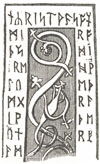Celtic Language
The Celtic language is now admittedly one of the most ancient in existence. Its affinity with Sanscrit, the eldest daughter of the undiscoverable mother-tongue, has been amply proved,[6] and the study of the once utterly despised Irish promises to be one which will abundantly repay the philologist. It is to be regretted that we are indebted to German students for the verification of these statements; but the Germans are manifestly born philologists, and they have opportunities of leisure, and encouragement for the prosecution of such studies, denied to the poorer Celt. It is probable that Celtic will yet be found to have been one of the most important of the Indo-European tongues. Its influence on the formation of the Romance languages has yet to be studied in the light of our continually increasing knowledge of its more ancient forms; and perhaps the conjectures of Betham will, by the close of this century, receive as much respect as the once equally ridiculed history of Keating.
It is almost impossible to doubt that the Irish nation had letters and some form of writing before the arrival of St. Patrick. There are so many references to the existence of writings in the most ancient MSS., that it appears more rash to deny their statements than to accept them. The three principal arguments against a pre-Christian alphabet appears to be: (1) The absence of any MS. of such writing. (2) The use of the Roman character in all MSS. extant. (3) The universal opinion, scarcely yet exploded, that the Irish Celts were barbarians. In reply to the first objection, we may observe that St. Patrick is said to have destroyed all the remnants of pagan writing.[7] Caesar mentions that the druids of Gaul used Greek characters. It appears impossible that the Irish druids, who were at least their equals in culture, should have been destitute of any kind of written character. The ancient form of Welsh letters were somewhat similar to the runes of which we give a specimen, and this alphabet was called the "alphabet of the bards," in contradistinction to which is placed the "alphabet of the monks," or Roman alphabet. The alphabet of the Irish bard may have been the Beith-luis-nion, represented by the Ogham character, of which more hereafter.
There are so many references to the existence of writings in the most ancient MSS., that it appears more rash to deny their statements than to accept them. The three principal arguments against a pre-Christian alphabet appears to be: (1) The absence of any MS. of such writing. (2) The use of the Roman character in all MSS. extant. (3) The universal opinion, scarcely yet exploded, that the Irish Celts were barbarians. In reply to the first objection, we may observe that St. Patrick is said to have destroyed all the remnants of pagan writing.[7] Caesar mentions that the druids of Gaul used Greek characters. It appears impossible that the Irish druids, who were at least their equals in culture, should have been destitute of any kind of written character. The ancient form of Welsh letters were somewhat similar to the runes of which we give a specimen, and this alphabet was called the "alphabet of the bards," in contradistinction to which is placed the "alphabet of the monks," or Roman alphabet. The alphabet of the Irish bard may have been the Beith-luis-nion, represented by the Ogham character, of which more hereafter.
The difficulty arising from the fact of St. Patrick's having given abgitorium, or alphabets, to his converts, appears to us purely chimerical. Latin was from the first the language of the Church, and being such, whether the Irish converts had or had not a form of writing, one of the earliest duties of a Christian missionary was to teach those preparing for the priesthood the language in which they were to administer the sacraments. The alphabet given by the saint was simply the common Roman letter then in use. The Celtic characteristic veneration for antiquity and religion, has still preserved it; and strange to say, the Irish of the nineteenth century alone use the letters which were common to the entire Roman Empire in the fifth. The early influence of ecclesiastical authority, and the circumstance that the priests of the Catholic Church were at once the instructors in and the preservers of letters, will account for the immediate disuse of whatever alphabet the druids may have had. The third objection is a mere argumentum ad ignorantiam.
Notes
[6] Proved.—See Pictet's Origines Indo-Européennes. He mentions his surprise at finding a genuine Sanscrit word in Irish, which, like a geological boulder had been transported from one extremity of the Aryan world to the other. Pictet considers that the first wave of Aryan emigration occurred 3,000 years before the Christian Era.
[7] Writing.—"Finally, Dudley Firbisse, hereditary professor of the antiquities of his country, mentions in a letter [to me] a fact collected from the monuments of his ancestors, that one hundred and eighty tracts [tractatus] of the doctrine of the druids or magi, were condemned to the flames in the time of St. Patrick."—Ogygia, iii. 30, p. 219. A writer in the Ulster Arch. Journal mentions a "Cosmography," printed at "Lipsiae, 1854." It appears to be a Latin version or epitome of a Greek work. The writer of this Cosmography was born in 103. He mentions having "examined the volumes" of the Irish, whom he visited. If this authority is reliable, it would at once settle the question.—See Ulster Arch. Journal, vol. ii. p. 281.
